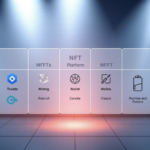Now Reading: DeFi Explained Simply: Understand Decentralized Finance
- 01
DeFi Explained Simply: Understand Decentralized Finance
DeFi Explained Simply: Understand Decentralized Finance

Imagine a financial system where anyone with internet access can borrow, lend, or trade assets without banks or brokers. This is the promise of decentralized finance (DeFi), a blockchain-based movement reshaping how we interact with money. Born from Bitcoin’s 2009 innovation, DeFi expands on cryptocurrency’s core idea: cutting out middlemen to give users direct control.
Traditional finance relies on institutions to manage transactions and enforce rules. DeFi replaces these gatekeepers with self-executing smart contracts hosted on networks like Ethereum. These digital agreements power decentralized apps (DApps) that handle everything from loans to insurance. Over $50 billion in assets are now locked in these protocols, proving real-world adoption.
What makes this system revolutionary? It operates 24/7 across borders, serving both Wall Street traders and unbanked populations. Nearly 2 billion people worldwide lack access to basic banking – DeFi could change that through smartphone apps and crypto wallets. Early adopters already use platforms for decentralized finance platforms to earn interest rates that outpace traditional savings accounts.
While risks exist – like smart contract vulnerabilities – the growth of total value locked (TVL) shows increasing trust. This metric tracks assets deposited in DeFi protocols, acting as a health indicator for the ecosystem. As technology improves, decentralized networks might redefine financial freedom in our digital age.
Key Takeaways
- Emerged from Bitcoin’s decentralized principles to enable broader financial services
- Replaces banks with automated smart contracts on blockchain networks
- Ethereum hosts most protocols, with $50+ billion in assets currently in use
- Operates globally without geographic restrictions or banking hours
- TVL metric demonstrates real-world adoption and ecosystem health
- Potential solution for 2 billion people lacking traditional banking access
Introducing Decentralized Finance
The global financial landscape is undergoing a radical shift as blockchain technology enables direct peer-to-peer transactions without centralized control. This new model challenges century-old systems by letting individuals manage assets through code rather than corporations.

What Is This System and Why Does It Matter?
Traditional financial institutions act as gatekeepers, holding customer funds and approving transactions. The 2008 banking crisis revealed the dangers of this setup—when intermediaries fail, entire economies suffer. Blockchain-based alternatives remove single points of failure through distributed networks where users retain ownership.
Modern solutions operate as trustless systems. Transactions occur directly between parties using self-verifying smart contracts. This eliminates reliance on third-party validators while maintaining security through cryptographic proofs.
Comparing Old and New Financial Models
Legacy banking faces three core limitations:
- Limited operating hours for cross-border transfers
- 3-5 day settlement periods for international payments
- Geographic restrictions blocking access
Decentralized networks solve these through 24/7 availability and transactions that finalize in minutes. Anyone with internet can participate without submitting personal documents or meeting minimum balance requirements.
Open-source code allows transparent auditing of financial protocols. Developers worldwide can improve existing tools without corporate approval. This collaborative approach contrasts sharply with traditional systems where financial services operate behind closed doors.
Understanding How DeFi Works with Smart Contracts
At the core of decentralized systems lie two transformative technologies: blockchain networks and self-enforcing digital agreements. These innovations work together to create financial tools that operate without corporate oversight or geographic limitations.

The Role of Blockchain in Financial Services
Blockchain serves as the digital backbone for modern financial applications. This distributed ledger records every transaction across thousands of computers, ensuring data remains unaltered and accessible worldwide. Unlike traditional databases controlled by banks, blockchain networks allow anyone to verify transactions through cryptographic proofs.
Financial activities on these networks become transparent and resistant to censorship. Each action—whether a loan payment or asset transfer—receives a permanent timestamp. This immutability prevents fraud while giving users full control over their funds.
Smart Contracts: The Backbone of Autonomous Finance
Self-executing code known as smart contracts form the operational framework for decentralized platforms. These digital agreements automatically transfer assets when predefined conditions occur, like releasing loan funds after collateral verification. Smart contracts eliminate intermediaries by handling enforcement through code rather than human oversight.
Here’s how they work in practice:
- Developers program rules into blockchain-based contracts
- Users interact with these protocols through crypto wallets
- Transactions finalize automatically when requirements meet
This automation enables complex financial services—from interest-bearing accounts to insurance pools—to operate 24/7 without traditional institutions. The combination of blockchain’s transparency and smart contracts’ precision creates a new paradigm for global finance.
DeFi explained simply: A Beginner’s Perspective
Navigating financial tools without banks might sound futuristic, but blockchain technology makes it possible. These systems use coded rules instead of human managers, letting people exchange value directly. Let’s unpack the essential terms that power this innovation.
Defining Key Terms and Concepts
Protocols act like digital rulebooks. They govern how crypto moves between users on a blockchain network. When you deposit digital money as collateral, smart contracts automatically hold those assets until you repay loans.
Three pillars support these systems:
- Liquidity pools: Shared crypto reserves enabling instant trades
- Yield farming: Earning rewards by lending digital assets
- Decentralized exchanges: Platforms for swapping tokens without intermediaries
Here’s how borrowing works: You send cryptocurrency to a protocol, which locks it as security. The system then lends you different assets based on that collateral. Repay the loan, and your original crypto gets released.
These solutions operate across multiple blockchain networks, creating a global financial web. Over 40% of adults worldwide lack bank accounts – blockchain-based tools could give them access through smartphones. By understanding these core concepts, anyone can start exploring this evolving ecosystem.
Exploring Core DeFi Applications and Use Cases
Blockchain-based financial tools now offer practical solutions for managing digital assets. These systems create open markets where code replaces middlemen, enabling users to access services directly through crypto wallets.

Lending Platforms, Stablecoins, and Money Markets
Lending protocols dominate decentralized finance activity. Platforms like Aave let users borrow funds by locking cryptocurrency as collateral. Borrowers maintain ownership of their assets while accessing liquidity, with over $20 billion currently locked in these systems.
Stablecoins act as anchors in volatile markets. Tether (USDT) and USD Coin (USDC) mirror the dollar’s value, enabling predictable transactions. These tokens bridge traditional finance and blockchain networks, reducing risk for daily transactions.
Money markets connect global lenders and borrowers through automated systems. Interest rates adjust dynamically based on supply and demand, creating competitive returns unavailable through conventional banks.
Yield Farming, Liquidity Pools, and Decentralized Exchanges
Yield farming rewards users for staking crypto in liquidity pools. Participants earn fees and governance tokens by providing trading pairs like ETH/USDC. These incentives drive participation while decentralizing platform ownership.
Decentralized exchanges (DEXs) like Uniswap use pooled assets instead of order books. Automated market makers set prices algorithmically, enabling 24/7 trading without KYC checks. Liquidity providers earn a share of transaction fees, creating passive income opportunities.
Together, these tools form an interconnected ecosystem. Users can lend stablecoins, farm yields, and trade assets – all through non-custodial platforms that prioritize accessibility over gatekeeping.
Benefits and Risks of Decentralized Finance
Blockchain-powered financial systems empower users with unprecedented control over assets while introducing new challenges. These platforms remove traditional gatekeepers but demand personal responsibility for security and decision-making.
Unlocking Financial Freedom and Transparency
Global access transforms financial participation. A farmer in Kenya can earn interest on crypto savings through a smartphone app, bypassing local banking restrictions. Transactions settle in minutes, not days, with fees often under $1.
Three transparency advantages stand out:
- All transactions appear on public ledgers
- Smart contract code remains visible for audits
- Protocol changes require community voting
This openness helps users verify operations independently. Annual percentage yields (APYs) frequently exceed 5% on stablecoins compared to 0.5% bank rates.
Understanding Market Volatility and Security Concerns
Crypto’s wild price swings can erase gains overnight. A 20% token drop might wipe out a year’s yield from staking rewards. Smart contracts also carry risks – $2 billion was stolen through exploits in 2023 alone.
Key dangers include:
- Fake platforms promising 100%+ returns
- Network congestion spiking transaction fees
- Developers abandoning projects unexpectedly
Users must research protocols thoroughly and manage private keys securely. While blockchain offers robust security frameworks, human error remains the weakest link in protecting funds.
DeFi and Traditional Finance: Challenging the Status Quo
Financial power dynamics are shifting as peer-to-peer networks redefine value exchange. Traditional institutions face unprecedented pressure from systems that bypass gatekeepers entirely. Banks and brokers now confront a critical choice: adapt or risk irrelevance in this evolving financial landscape.
How Peer-to-Peer Models Disrupt Banks and Intermediaries
Decentralized networks remove rent-seeking middlemen from transactions. A $10,000 international transfer costing $500 through banks now executes for under $5 via blockchain. This efficiency forces traditional players to slash fees and accelerate processing times.
Major banks are responding by testing private blockchains for settlements. JPMorgan’s Onyx network processes $1 billion daily, while BNY Mellon custody services now include digital assets. These efforts aim to retain customers drawn to faster, cheaper alternatives.
Three regulatory hurdles slow institutional adoption:
- Compliance with anti-money laundering (AML) laws
- Capital reserve requirements for crypto exposures
- Jurisdictional disputes over decentralized protocols
Despite challenges, 63% of financial executives consider blockchain integration essential. Hybrid models are emerging where banks offer crypto wallets alongside traditional accounts. This fusion combines decentralized speed with institutional safeguards.
The future likely holds coexistence rather than total replacement. Traditional systems excel at consumer protections, while decentralized networks lead in accessibility. As both models evolve, users gain more choices in managing their money.
Innovative Trends and Future Prospects in DeFi
Blockchain ecosystems are evolving beyond single-network limitations. Major platforms like Ethereum and Solana now compete to optimize transaction speeds while cutting fees. This rivalry drives technical breakthroughs that benefit users across decentralized applications.
Emerging Technologies and Cross-Chain Solutions
New protocols enable seamless asset transfers between networks. Polkadot’s parachains and Cosmos’ inter-blockchain communication let applications share data across separate ledgers. Hybrid smart contracts merge on-chain code with real-world data through oracle networks, expanding use cases.
Layer-2 solutions like Optimism reduce Ethereum’s congestion. These upgrades support complex financial products while maintaining security. Cross-chain bridges now handle $5B+ daily volume, proving demand for interconnected blockchain economies.
Potential Growth and Regulatory Considerations
Non-financial applications are gaining traction. Blockchain-based gaming and supply chain tools use similar frameworks to DeFi solutions. Digital identity systems could soon integrate with lending platforms for credit scoring.
Regulators are drafting rules for cross-border transactions and tax compliance. The SEC’s recent actions highlight tensions between innovation and investor protection. Clear guidelines could attract institutional capital while safeguarding users from systemic risks.
FAQ
How do blockchain-based financial services differ from traditional banking?
Blockchain eliminates intermediaries like banks by using distributed ledgers. Transactions occur directly between users via smart contracts, reducing fees and increasing speed. This peer-to-peer model offers global access without relying on centralized institutions.
What risks should users consider before participating in liquidity mining?
Liquidity mining involves exposure to impermanent loss, where asset values fluctuate compared to their initial deposit. Protocol vulnerabilities and sudden market shifts can also impact returns. Platforms like Uniswap or Compound require careful research to assess smart contract security.
Can stablecoins maintain stability during extreme crypto volatility?
Major stablecoins like USDC and DAI use collateral reserves or algorithms to peg values to fiat currencies. While designed for stability, black swan events or collateral shortages—as seen with TerraUSD’s collapse—can disrupt this balance, requiring robust auditing mechanisms.
How do decentralized exchanges prevent price manipulation?
Platforms such as SushiSwap use automated market makers (AMMs) and liquidity pools to set prices algorithmically. However, low-liquidity tokens remain susceptible to slippage. Oracles like Chainlink enhance security by providing real-time external data feeds to reduce manipulation risks.
Why are cross-chain solutions critical for future growth in this space?
Projects like Polkadot and Cosmos enable interoperability between blockchains, allowing assets to move seamlessly across networks. This reduces fragmentation, improves scalability, and supports complex applications like cross-border lending or multi-chain yield farming strategies.
What regulatory challenges could impact peer-to-peer lending platforms?
Governments may impose KYC/AML requirements on protocols like Aave, conflicting with decentralization principles. Tax reporting rules and jurisdiction-specific compliance could also affect how users interact with permissionless money markets globally.













